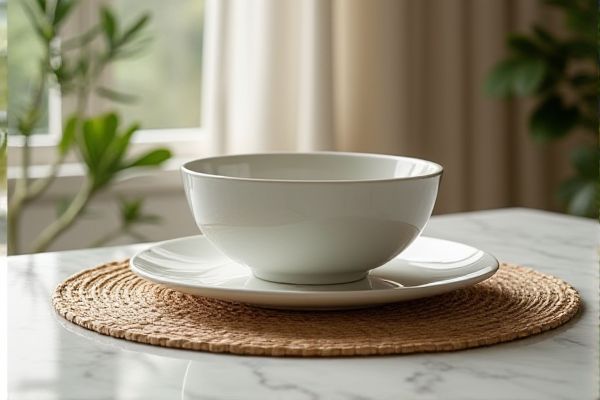
Placemats and coasters serve different purposes in protecting your table: placemats shield larger areas from spills and heat, while coasters specifically prevent water rings and heat marks from cups. Understanding their distinct uses can help you choose the right product for your dining needs; continue reading to explore their materials, designs, and ideal applications.
Table of Comparison
| Feature | Placemat | Coaster |
|---|---|---|
| Purpose | Protects table surface from heat, spills, and scratches during meals | Protects table from moisture rings caused by glasses and cups |
| Size | Large, typically 12 x 18 inches | Small, typically 4 x 4 inches or round |
| Material | Fabric, plastic, bamboo, cork | Wood, cork, silicone, ceramic |
| Placement | Under plates and utensils | Under glasses and mugs |
| Functionality | Defines individual dining space and protects table | Absorbs condensation and prevents surface damage |
| Design Variety | Wide range including decorative and formal styles | Variety of shapes and themes, often decorative |
| Cleaning | Usually washable or wipeable | Easy to clean; often dishwasher-safe |
| Cost | Moderate to high depending on material and design | Generally low to moderate |
Introduction to Placemats and Coasters
Placemats and coasters serve distinct roles in protecting surfaces during meals and drink times; placemats shield entire table settings from spills and scratches, while coasters provide a dedicated spot for cups and glasses to prevent water rings and heat damage. Choosing the right placemat or coaster involves considering materials like fabric, cork, or silicone, which offer diverse levels of durability and style. Your selection influences both the functionality and aesthetic appeal of your dining experience.
Key Differences Between Placemats and Coasters
Placemats and coasters serve distinct purposes in protecting surfaces during meals: placemats shield larger areas like dining tables from spills, heat, and scratches, while coasters specifically protect smaller areas under drinks from condensation and heat marks. Placemats measure around 12 by 18 inches, providing ample space for plates and utensils, whereas coasters typically range from 3.5 to 4 inches in diameter, designed to fit under cups or glasses. Your choice depends on whether you need broad surface protection or a compact barrier solely for beverages.
Primary Functions of Placemats
Placemats primarily protect your dining table from spills, heat, and scratches while adding a decorative element to your table setting. They define individual place settings, helping to organize and enhance the overall dining experience. Unlike coasters, which are designed specifically for holding drinks, placemats cover larger surface areas to shield against a variety of kitchen or dining hazards.
Main Uses of Coasters
Coasters primarily protect your furniture from moisture rings, heat damage, and scratches caused by cups and glasses. They absorb condensation from cold drinks and provide a stable surface to prevent spills. Unlike placemats, which cover larger areas, coasters are designed for individual drinkware, ensuring your tabletops remain clean and damage-free.
Material Varieties: Placemats vs. Coasters
Placemats are typically made from materials such as woven fabric, vinyl, bamboo, and cork, designed to cover larger surface areas and protect tables from heat, spills, and scratches. Coasters often utilize absorbent materials like cork, ceramic, silicone, or wood to prevent moisture rings and condensation on furniture. Both placemats and coasters offer diverse material varieties tailored to their specific functional needs and aesthetic preferences.
Design and Style Considerations
Placemat designs often feature larger, eye-catching patterns and textures that complement dining table aesthetics while protecting surfaces from spills and heat. Coasters are typically smaller with intricate or minimalistic styles tailored for individual drinkware, emphasizing functionality alongside decorative appeal. Both items enhance table settings by coordinating colors, materials, and thematic elements to suit formal or casual environments.
Durability and Maintenance Comparison
Placemats are typically larger and made from materials like woven fabric, vinyl, or bamboo, offering high durability and easy cleaning through wiping or machine washing. Coasters, often made from cork, ceramic, or silicone, provide robust protection against moisture and heat but may require occasional hand washing or spot cleaning to maintain appearance. Both accessories enhance table longevity, but placemats generally demand less frequent maintenance, while coasters offer targeted durability for drinkware protection.
Suitable Occasions for Each
Placemats are ideal for formal dinners, family meals, and holiday gatherings where protecting the table from spills and heat is essential while adding decorative flair. Coasters suit casual settings like coffee tables, bars, and everyday use to prevent water rings and surface damage from individual glasses or mugs. Your choice depends on the occasion's formality and whether you need surface protection for individual drinks or entire place settings.
Cost-Effectiveness and Value
Placemats offer greater cost-effectiveness for protecting larger table surfaces during meals, often made from durable, reusable materials like vinyl or fabric, providing long-term value. Coasters, typically smaller and less expensive, target protection against beverage rings and spills but may need to be purchased in multiples to cover extensive use. Investing in quality placemats combined with coasters maximizes overall table protection while balancing budget considerations effectively.
Choosing the Right Option: Placemats or Coasters
Choosing between placemats and coasters depends on your need to protect surfaces from different types of damage; placemats shield larger areas from spills, heat, and stains during meals, while coasters are ideal for preventing water rings and heat marks from drinks. Consider the material and design that complement your decor and the level of protection required for your furniture. Your decision should balance practicality with aesthetic appeal to maintain the longevity and appearance of your table settings.
 homyna.com
homyna.com